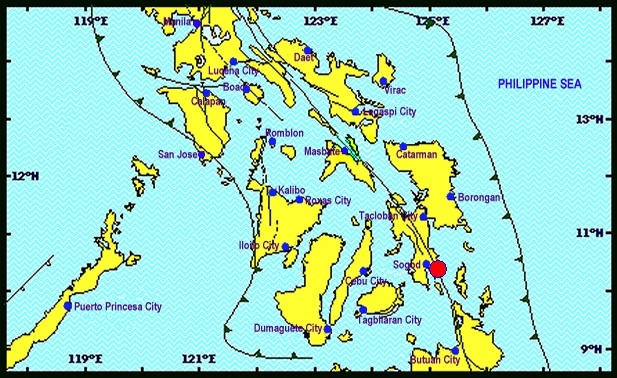On January 9, 2025 at 3:12 in the morning. A magnitude 4.3 earthquake struck the municipality of Hinunangan, located in Southern Leyte, Philippines. As residents and local authorities brace for aftershocks and potential seismic hazards, many are left wondering. Could this earthquake be related to the nearby Mount Cabalian, an active volcano in the region? Next, we must consider how the local community should prepare for a potential future volcanic eruption.

Understanding the Earthquake in Hinunangan. The earthquake struck Hinunangan a coastal municipality located not far from Mount Cabalian, one of Southern Leyte’s active volcanoes. The Philippines, situated in the Pacific Ring of Fire. The Philippines experiences frequent earthquakes due to the convergence of tectonic plates, consequently triggering both volcanic activity and seismic events. Although this particular earthquake may not be directly linked to volcanic activity, it nevertheless underscores the region’s significant tectonic movements.
According to the (PHIVOLCS), earthquakes like the one experienced in Hinunangan are often caused by the movement of tectonic plates. It is beneath the earth’s surface, which may or may not be related to nearby volcanic activity. While it’s not unusual for earthquakes to occur near active volcanoes like Mount Cabalian. The 4.3-magnitude tremor is most likely a result of the ongoing tectonic activity in the region. Rather than a direct sign of volcanic unrest.
Is the Earthquake Related to Mount Cabalian?
Although Mount Cabalian is an active stratovolcano, this earthquake doesn’t appear linked to volcanic activity. The quake was moderate, and PHIVOLCS hasn’t detected volcanic tremors or signs of an imminent eruption. It’s important to understand that volcanic earthquakes (also called volcanic tremors) occur due to magma movement beneath the surface. Volcanic earthquakes often occur in areas directly impacted by volcanic activity, distinguishing them from those caused by tectonic shifts. However, many earthquakes near active volcanoes, like Mount Cabalian, originate from tectonic plate movements.
How to Prepare for a Possible Eruption of Mount Cabalian?
Even if the Hinunangan earthquake isn’t an eruption precursor. Preparedness for volcanic activity is crucial for those living near Mount Cabalian and other active Philippine volcanoes. Volcanic eruptions can occur unexpectedly, and Mt. Cabalian, as an active volcano, poses potential risks to nearby communities.
Is Southern Leyte prone to earthquake?
Based on current information, Southern Leyte faces a high earthquake hazard. There’s over a 20% chance of damaging earthquake shaking in the next 50 years.
Here are several steps that local residents and visitors should take to prepare for a potential volcanic eruption:
- Stay Informed
Monitor PHIVOLCS for the latest volcanic activity alerts. If Mount Cabalian shows increased seismic activity, gas emissions, or ground deformation, PHIVOLCS will issue advisories.
Follow instructions from local Southern Leyte authorities during an eruption. - Create an Emergency Plan
Evacuation Routes: Know the evacuation routes in your community and have a plan in place for reaching safety. Identify safe zones away from the volcano and know where the nearest evacuation center is.
Establish a communication plan with family, especially those living in volcanic hazard zones.
Prepare an emergency kit with first aid, food, water, a flashlight, a radio, and face masks. - Prepare for Ashfall
If an eruption occurs, ashfall can cover large areas. Ash can damage crops, buildings, and water supplies and pose serious health risks, especially to those with respiratory issues.
Protective Gear: Wear long-sleeved clothes, goggles, and face masks when stepping outside during ashfall. Keep your windows and doors closed to prevent ash from entering your home.
Water Supply: Store clean drinking water and food supplies in case the eruption disrupts local water sources or agricultural production. - Understand Volcanic Hazards
Lava flows, while dangerous, usually move slowly, allowing for evacuation with timely warnings.
Pyroclastic flows, fast-moving clouds of hot gas and debris, are highly dangerous and can be fatal. Avoid areas near the volcano if any warning signs of an impending eruption are given.
Tsunamis: Coastal areas like Hinunangan may be at risk of tsunamis if the volcano experiences an underwater eruption. Have a tsunami evacuation plan in place, especially for those living in low-lying coastal areas. - Educate Your Community
Awareness is key. Educate local communities about the risks of volcanic eruptions and the importance of disaster preparedness. Participate in local drills, and encourage family and friends to make emergency plans and keep emergency supplies.
Conclusion
The Hinunangan earthquake likely stems from regional tectonic activity, not a pending Mt. Cabalian eruption. However, living near an active volcano means that residents must always be prepared for the possibility of volcanic activity. Staying informed, creating emergency plans, and understanding volcanic hazards are crucial for preparing for a potential Mount Cabalian eruption.

Hi, this is a comment.
To get started with moderating, editing, and deleting comments, please visit the Comments screen in the dashboard.
Commenter avatars come from Gravatar.